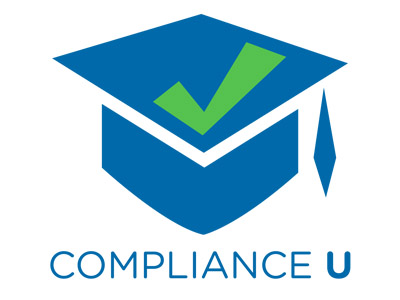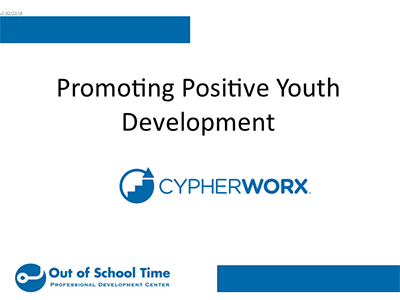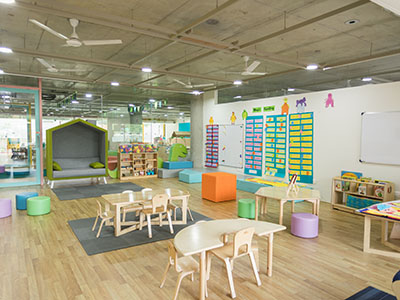 |
Healthy Bodies: Promoting Good Nutrition and Physical Activity in Child Care |
1.00 |
This course will give you a broad overview of how to instill healthy habits at an early age. It will provide you with information about the nutritional needs of children and the benefits and risks associated with physical activity levels. Strategies will be given to use this knowledge in the classroom. |
 |
Presentation Methods and Debriefing Activities |
2.00 |
There is no "one size fits all" approach to working with children and youth, and this is especially true when it comes to how we present and debrief activities. During this course, participants will understand the importance of the delivery and debriefing of an activity to help children and youth make meaning, as well as some specific methods that can be incorporated into the program right away. |
 |
Food Allergy Basics: Emergency Response |
1.00 |
Welcome to Food Allergy Basics: Emergency Response. This course is focused on how to use a Food Allergy and Anaphylaxis Emergency Care Plan to care for a child with a food allergy.
Course Learning Objectives:
- Explain the correct use of the Food Allergy and Anaphylaxis Emergency Care Plan.
- Identify the six rights of medication administration. |
 |
Dance for Joy: Movement, Music, and Rhyme |
1.00 |
This module from Dance for Joy will provide teachers with resources and activities that can be used and modified to support physical, mental, social, and emotional development in young children.
This course covers 5 activities: I Touch My Nose, I Touch My Toes, Hold Yourself Tight, Wake Up Right, Reach One Way, Reach the Other, Locomotor Freeze Dance, Salt and Pepper Dance. |
 |
After School Improvement Series: Outdoor Environments |
0.50 |
The After School Improvement Series: Outdoor Environments course will:
Describe different types of outdoor environments, along with the opportunities and challenges each one offers.
Discuss the role outdoor environments play in encouraging children to be active, while promoting a range of different experiences.
Identify the steps you can take to ensure that the outdoor environment is safe and accessible for all children.
Explore how outdoor environments can be used to extend learning opportunities found in indoor environments.
|
 |
OSTPD - Supporting Alternative Pathways through Service Learning |
1.00 |
This training will cover a number of areas regarding how after school programs can support alternative pathways by using service learning. The course will review what service learning is and provide a solid foundation of this concept. It will then look at the benefits of service learning followed by how service learning supports youth’s alternative pathways. It will conclude with information on how to get started and creating a path to implement service learning in your own program.
|
 |
OSTPD - Promoting Positive Youth Development |
1.00 |
This training will define Positive Youth Development, benefits of Positive Youth Development and how to implement Positive Youth Development. |
 |
OSTPD - Supporting Attendance through After School Programming |
1.00 |
This training will cover a number of areas regarding how after school programs can support youth attendance in school. By looking at and exploring the connection between after school programming and attendance in school, we see how after school programming supports attendance at school as well as how to coordinate with the school in order to maximize the positive impact of after school on school attendance through collaboration. |
 |
Become an Energenius® |
2.00 |
CalSAC has partnered with the Pacific Gas & Electric Company (PG&E) to bring the Energenius® Out-of-School Time Program to our online training platform. This FREE environmental stewardship curriculum is designed to engage children and youth to think about how they use energy, how energy is measured, paid for, and ways to save energy. Children and youth will understand how they can help reduce the impacts of energy use and production on the environment, and also practice influencing others to take energy-saving actions. Additionally, the curriculum is uniquely and intentionally designed to engage families in energy and water conservation habits.
Become an Energenius® is Activity Guide #4 in the 4-part Energenius® Out-of-School Time Program. The curriculum and activities are designed to engage children and youth to think about how they can save energy, how to recycle, reduce and reuse, and actions they will take to promote energy efficiency in their homes and community. This course will prepare participants to deliver the activities from the Become an Energenius® Activity Guide as well as sharing energy saving resources with families. |
 |
Infectious Diseases: Daily Health Check |
1.00 |
This course is focused on the daily health check, and how it relates to policy guidelines about whether or not children with symptoms of infectious diseases can participate in program activities.
Course Learning Objectives:
Describe the elements of a daily health check.
Discuss how daily health checks relate to policy guidelines about whether or not children with symptoms of infectious diseases can participate in program activities. |
 |
Reducing Turnover in Childcare Settings: Strategies for Administrators |
1.00 |
This course covers strategies for administrators to reduce turnover in childcare settings. It is just one out of many educational courses we offer. This course will help you develop new knowledge about the childcare setting and help you better understand your role as an administrator. |
 , ,  |
Dance for Joy: Confident, Calm, and Compassionate |
1.00 |
This module from Dance for Joy will provide teachers with resources and activities that can be used and modified to support physical, mental, social, and emotional development in young children.
This course covers 5 activities: Tickle the Sky, Tapping, Every Little Cell, We are One, Scoop up the Universe. |
 |
SIDS and Other Sleep-Related Infant Deaths: Keeping Babies Safe |
1.50 |
This course will give participants a brief overview of Sudden Infant Death Syndrome (SIDS) and other sleep-related deaths. Participants will learn about recent research and statistics, the importance of child care providers, AAP SIDS Task Force recommendations, and how to implement polices in child care. |
 |
Infectious Diseases: Causes and Symptoms |
1.00 |
An infectious disease is an illness that is caused by organisms such as bacteria, viruses, fungi, and parasites. Many of these organisms live in or on our bodies, and are normally harmless. But under certain circumstances, they can cause disease.
Course Learning Objectives:
- Describe infectious disease, and the ways in which germs that can cause infectious disease are spread.
- Identify common symptoms of infectious diseases, and why young children are vulnerable to infectious diseases. |
 |
Suicide Prevention |
1.25 |
This course covers suicide prevention measures and suicide prevention organizations as well as the disparities found in suicide data.
After completing this course, you will be able to:
Distinguish the disparities in suicide statistics
Identify the risk factors that can lead to suicide
Apply techniques to help prevent suicide
Describe the work that suicide prevention programs are doing |
 |
Medication Administration in Child Care |
0.50 |
This course covers Medication Administration in Child Care. It is just one out of many educational courses we offer. This course will help you develop new knowledge about children and help you better understand your role. In this course, you will learn about common medications children may take while under your care and the policies and guidelines for administering them. You will also read about adverse reactions and how to respond in an emergency. You will gain a greater understanding of the importance of safe drug administration. |
 |
Engaging English Learner Families and Communities |
2.00 |
This online course serves as a compliment to Healthy Cultural Identities and Engaging Families and Communities, an in-person training offered through CalSAC's English Learner Training and Professional Development Project. This course will help participants go deeper and gain more examples and strategies related to some of the 5 Tips for Engaging English Learners' Families and Communities introduced in the training. |
 |
Food Allergy Basics: Symptoms and Triggers |
1.00 |
Welcome to Food Allergy Basics: Symptoms and Triggers. This course identifies the symptoms and triggers of food allergies.
Course Learning Objectives:
- Define food allergy.
- Identify the foods that cause 90% of all food allergies.
- List the symptoms of food allergies. |
 |
Infectious Diseases: Environmental Management |
1.00 |
This course is focused on reducing the risk of infectious diseases in early care and education environments.
Course Learning Objectives:
List environmental management strategies for reducing the spread of germs that cause infectious disease. |
 |
Development and Characteristics of Learners for Teachers |
1.00 |
Development and Characteristics of Learners will assist you in fostering a solid understanding of how children develop and the disability categories that may impact their learning. This course will also help you gain invaluable insight into ways you can support children and meet their needs. |
 |
Autism and Bullying |
0.50 |
This course covers Autism spectrum disorder (ASD) and Bullying. The course will begin by going over what autism is, and then it will continue to teach you about the bullying that may occur along with it, and how you can assist. This content will help you learn more about children with ASD and will help you understand how you might support these children. |
 |
Attention-Deficit/Hyperactivity Disorder (ADHD) |
0.50 |
This course covers Attention-Deficit/Hyperactivity Disorder, also known as ADHD. A key discussion point of this course is whether ADHD is the wandering of attention, which is a trait, versus the deficit of attention, which is a disorder. We'll cover topics that include what ADHD is, its characteristics, the signs of ADHD, and possible medications or accommodations. It is just one out of many educational courses we offer. This course will help you develop new knowledge about children and help you better understand your role. |
 |
Understanding Autism in Your Community |
1.00 |
This course is designed to educate communities on how they can work together to be more inclusive and accepting of people with autism. It will give you an overview of the struggles people with autism face and some ways in which communities can make themselves more accessible and autism-friendly. |
 |
Dyslexia |
1.00 |
This course will provide you with an overview of dyslexia to help you understand what it is all about, the challenges a student with dyslexia faces, and the best ways in which teachers can effectively support students with this disability. |
 |
Energy and You! |
2.00 |
CalSAC has partnered with the Pacific Gas & Electric Company (PG&E) to bring the Energenius® Out-of-School Time Program to our online training platform. This FREE environmental stewardship curriculum is designed to engage children and youth to think about how they use energy, how energy is measured, paid for, and ways to save energy. Children and youth will understand how they can help reduce the impacts of energy use and production on the environment, and also practice influencing others to take energy-saving actions. Additionally, the curriculum is uniquely and intentionally designed to engage families in energy and water conservation habits.
Energy and You is Activity Guide #1 in the 4-part curriculum Energenius® Out-of-School Time Program. The curriculum and activities are designed to engage children and youth to think about how they use energy, how energy is measured and paid for, and ways to save energy. This course will prepare participants to deliver the activities from the Energy and You Activity Guide as well as connect families to resources to help save energy and money. |











 ,
, 














